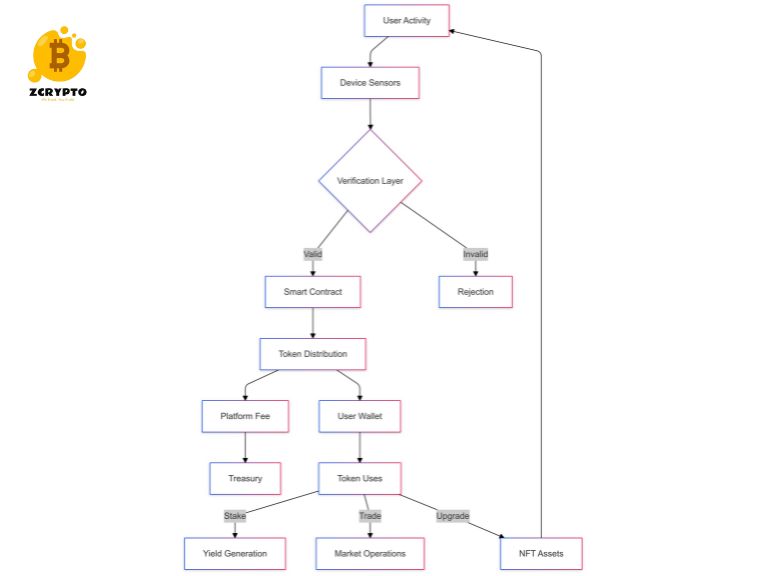- Binance Coin (BNB) Price Prediction 2024-2030: Future Prospects and Investment Potential
- Maximize Returns with a 100% Equities Strategy: Benefits, Risks, and Implementation Guide
- How to Calculate and Interpret Cash Flow from Operating Activities (CFO): A Comprehensive Guide
- What is Music NFT? Transforming Artist-Fan Relationships
- Understanding Capitalism: How Free Markets Shape Global Economics and Investments
Move to Earn (M2E) platforms operate through blockchain-based systems that link physical activity tracking with cryptocurrency rewards. These systems quantify user movement data through smartphone sensors and wearable devices, converting verified physical actions into token-based incentives.
You are viewing: What is Move to Earn? A Technical Analysis of Performance-Based Cryptocurrency Rewards
STEPN exemplifies this model with its GPS-tracked outdoor activities generating Green Satoshi Tokens (GST). Users must purchase NFT sneakers to participate, creating an asset-based entry barrier that maintains economic equilibrium. The platform takes a percentage of marketplace transactions and token trades to sustain operations.
The technical infrastructure relies on proof-of-movement protocols integrated with blockchain networks. Platforms like Sweatcoin operate on the NEAR Protocol blockchain, processing movement data through proprietary algorithms before issuing rewards. This creates a verifiable chain of activity validation.
Reward Distribution Architecture
M2E platforms implement multi-layered reward calculation systems considering factors like:
Movement intensity Duration of activity NFT asset characteristics User achievement levels Token economic parameters
For instance, STEPN’s reward formula incorporates:
Base earnings = (Movement points × Token rate) × (1 + NFT bonus multiplier)
The distribution occurs through smart contracts that automatically release tokens upon meeting verified movement thresholds. These contracts include anti-gaming measures like speed limits and cool-down periods.
Technical Infrastructure
M2E applications integrate several technological components:
Blockchain networks process transactions and maintain token systems. Solana powers STEPN’s infrastructure due to its high throughput and low transaction costs. Other platforms use alternative networks like BNB Chain or Polygon for their specific advantages.
Movement verification systems employ smartphone accelerometers, GPS tracking, and heart rate monitors. These data points feed into validation algorithms that confirm legitimate physical activity. The systems must account for device variations and environmental factors affecting sensor accuracy.
Smart contracts automate reward distribution based on predetermined conditions. These contracts contain logic for:
See more : How Activist Investors Drive Corporate Change and Boost Shareholder Value
Token emission rates Reward calculations Anti-fraud checks Asset management Transaction processing
Anti-Fraud Mechanisms
M2E platforms implement multiple security layers to maintain system integrity:
Geographic verification compares user locations against expected movement patterns. Sudden position changes trigger automated flags for review.
Machine learning algorithms analyze movement data to detect patterns indicating automated or falsified activity. These systems adapt to new exploitation attempts through continuous model updates.
Device fingerprinting tracks unique hardware identifiers to prevent multi-accounting. This combines with IP monitoring to identify suspicious access patterns.
Rate limiting prevents reward farming through cool-down periods between earning sessions. These limits scale with user level and asset quality to maintain economic balance.
Economic Model Analysis
M2E platforms generate revenue through multiple streams:
NFT marketplace fees Token trading commissions Premium feature subscriptions Partnership integrations Asset minting costs
The token economy typically involves dual-token systems:
Reward tokens for regular earning (e.g., GST in STEPN) Governance tokens for platform control (e.g., GMT in STEPN)
This separation allows platforms to maintain stable reward rates while preserving long-term value through governance tokens.
Entry costs vary by platform:
STEPN: NFT sneakers (100-1000 SOL) Genopets: Habitat NFTs (varied prices) Sweatcoin: Free entry with optional premium features

Platform Comparison Matrix
See more : Top Finance and Business Careers: Bureau of Labor Statistics (BLS) Insights and Salary Guides
M2E platforms differ in their approaches to activity verification and reward structures:
STEPN focuses on outdoor movement with GPS tracking Genopets incorporates gaming elements with character progression Sweatcoin accepts indoor activity through step counting OliveX requires specific movement patterns for different activities
Each platform maintains unique token economics:
Single vs. dual token systems Fixed vs. variable reward rates Direct vs. indirect monetization methods
Performance Metrics
Key indicators for M2E platform assessment:
Daily active users Token trading volume NFT floor prices User retention rates Average earnings per user
These metrics reveal platform health and economic sustainability. Successful platforms maintain balance between user acquisition costs and revenue generation.
Integration Technologies
M2E platforms leverage various technologies for seamless operation:
Wallet integration APIs Activity tracking SDKs Cross-chain bridges Data oracle networks Identity verification systems
These components enable secure data flow between physical activity and blockchain rewards.
Move to Earn represents an intersection of physical activity tracking and blockchain incentives. The success factors include:
Technical reliability Economic sustainability User engagement Fraud prevention effectiveness
Current implementations demonstrate various approaches to these challenges, with platforms differentiating through unique combinations of technology and tokenomics.
The field continues to adapt through technical innovations and economic model refinements. Successful platforms maintain careful balance between accessibility and sustainability while ensuring reliable activity verification.
Source: https://magnacumlaude.store
Category: Blog

